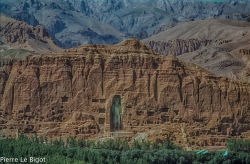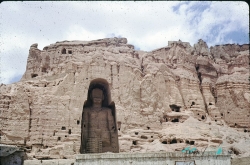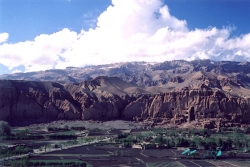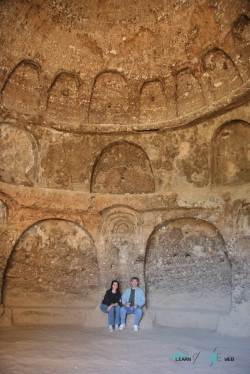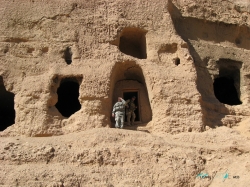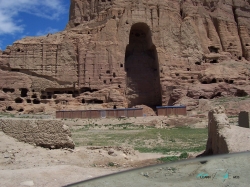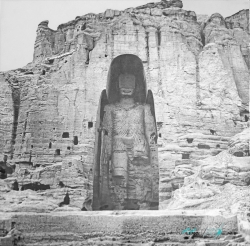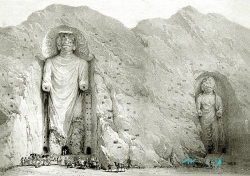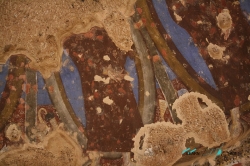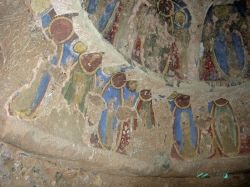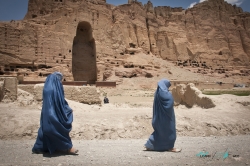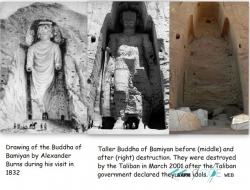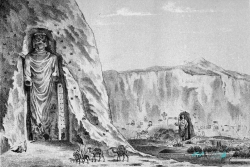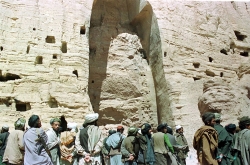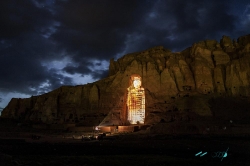The Buddhas of Bamiyan were two 6th-century monumental statues of Gautama Buddha carved into the side of a cliff in the Bamyan valley of central Afghanistan, 130 kilometres (81 mi) northwest of Kabul at an elevation of 2,500 metres (8,200 ft). Carbon dating of the structural components of the Buddhas has determined that the smaller 38 m (125 ft) "Eastern Buddha" was built around 570 AD, and the larger 55 m (180 ft) "Western Buddha" was built around 618 AD.
The statues represented a later evolution of the classic blended style of Gandhara art. The statues consisted of the male Salsal ("light shines through the universe") and the (smaller) female Shamama ("Queen Mother"), as they were called by the locals. The main bodies were hewn directly from the sandstone cliffs, but details were modeled in mud mixed with straw, coated with stucco. This coating, practically all of which wore away long ago, was painted to enhance the expressions of the faces, hands, and folds of the robes; the larger one was painted carmine red and the smaller one was painted multiple colors. The lower parts of the statues' arms were constructed from the same mud-straw mix supported on wooden armatures. It is believed that the upper parts of their faces were made from great wooden masks or casts. The rows of holes that can be seen in photographs held wooden pegs that stabilized the outer stucco.
The Buddhas are surrounded by numerous caves and surfaces decorated with paintings. It is thought that the period of florescence was from the 6th to 8th century CE, until the onset of Islamic invasions. These works of art are considered as an artistic synthesis of Buddhist art and Gupta art from India, with influences from the Sasanian Empire and the Byzantine Empire, as well as the country of Tokharistan.
The statues were blown up and destroyed in March 2001 by the Taliban, on orders from leader Mullah Mohammed Omar, after the Taliban government declared that they were idols. International and local opinion strongly condemned the destruction of the Buddhas. Some Taliban sources credited Omar's decision to blow up the Buddha Statue's to the growing influence of Osama bin Laden.
Bamyan lies on the Silk Road, which runs through the Hindu Kush mountain region, in the Bamyan Valley. The Silk Road has been historically a caravan route linking the markets of China with those of the Western world. It was the site of several Buddhist monasteries, and a thriving center for religion, philosophy, and art. Monks at the monasteries lived as hermits in small caves carved into the side of the Bamiyan cliffs. Most of these monks embellished their caves with religious statuary and elaborate, brightly colored frescoes, sharing the culture of Gandhara.
Bamiyan was a Buddhist religious site from the 2nd century AD up to the time of the Islamic invasion of the Abbasid Caliphate under Al-Mahdi in AD 770. It became again Buddhist from AD 870 until the final Islamic conquest of AD 977 under the Turkic Ghaznavid dynasty. Murals in the adjoining caves have been carbon dated from AD 438 to AD 980, suggesting that Buddhist artistic activity continued down to the final occupation by the Muslims.
The two most prominent statues were the giant standing sculptures of Buddhas Vairocana and Sakyamuni, identified by the different mudras performed. The Buddha popularly called "Solsol" measured 55 meters tall, and "Shahmama" 38 meters—the niches in which the figures stood are 58 and 38 meters respectively from bottom to top. Before being blown up in 2001 they were the largest examples of standing Buddha carvings in the world (the 8th century Leshan Giant Buddha is taller, but that statue is sitting). Plans for the construction of the Spring Temple Buddha were announced soon after the blowing up of the Bamiyan Buddhas and China condemned the systematic destruction of the Buddhist heritage of Afghanistan.
The statues represented a later evolution of the classic blended style of Gandhara art. The statues consisted of the male Salsal ("light shines through the universe") and the (smaller) female Shamama ("Queen Mother"), as they were called by the locals. The main bodies were hewn directly from the sandstone cliffs, but details were modeled in mud mixed with straw, coated with stucco. This coating, practically all of which wore away long ago, was painted to enhance the expressions of the faces, hands, and folds of the robes; the larger one was painted carmine red and the smaller one was painted multiple colors. The lower parts of the statues' arms were constructed from the same mud-straw mix supported on wooden armatures. It is believed that the upper parts of their faces were made from great wooden masks or casts. The rows of holes that can be seen in photographs held wooden pegs that stabilized the outer stucco.
The Buddhas are surrounded by numerous caves and surfaces decorated with paintings. It is thought that the period of florescence was from the 6th to 8th century CE, until the onset of Islamic invasions. These works of art are considered as an artistic synthesis of Buddhist art and Gupta art from India, with influences from the Sasanian Empire and the Byzantine Empire, as well as the country of Tokharistan.
The statues were blown up and destroyed in March 2001 by the Taliban, on orders from leader Mullah Mohammed Omar, after the Taliban government declared that they were idols. International and local opinion strongly condemned the destruction of the Buddhas. Some Taliban sources credited Omar's decision to blow up the Buddha Statue's to the growing influence of Osama bin Laden.
Bamyan lies on the Silk Road, which runs through the Hindu Kush mountain region, in the Bamyan Valley. The Silk Road has been historically a caravan route linking the markets of China with those of the Western world. It was the site of several Buddhist monasteries, and a thriving center for religion, philosophy, and art. Monks at the monasteries lived as hermits in small caves carved into the side of the Bamiyan cliffs. Most of these monks embellished their caves with religious statuary and elaborate, brightly colored frescoes, sharing the culture of Gandhara.
Bamiyan was a Buddhist religious site from the 2nd century AD up to the time of the Islamic invasion of the Abbasid Caliphate under Al-Mahdi in AD 770. It became again Buddhist from AD 870 until the final Islamic conquest of AD 977 under the Turkic Ghaznavid dynasty. Murals in the adjoining caves have been carbon dated from AD 438 to AD 980, suggesting that Buddhist artistic activity continued down to the final occupation by the Muslims.
The two most prominent statues were the giant standing sculptures of Buddhas Vairocana and Sakyamuni, identified by the different mudras performed. The Buddha popularly called "Solsol" measured 55 meters tall, and "Shahmama" 38 meters—the niches in which the figures stood are 58 and 38 meters respectively from bottom to top. Before being blown up in 2001 they were the largest examples of standing Buddha carvings in the world (the 8th century Leshan Giant Buddha is taller, but that statue is sitting). Plans for the construction of the Spring Temple Buddha were announced soon after the blowing up of the Bamiyan Buddhas and China condemned the systematic destruction of the Buddhist heritage of Afghanistan.



